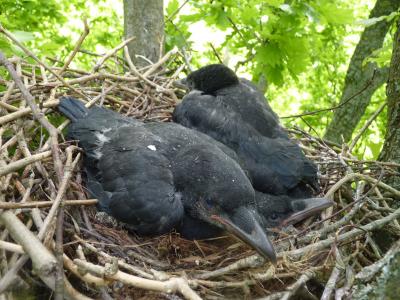The genes tell crows to choose partners that look alike

All-black carrion crow nestlings from a German population west of the hybrid zone. When crossing the zone, plumage colouration changes rapidly to the grey-coated hooded type. Credit: Jochen Wolf
What is the driving engine behind biodiversity? One and a half centuries years ago, Charles Darwin recognized that species are subject to evolutionary change. Now, we know that all aspects defining an organism are encoded in its genome. Yet, how new species emerge from slight genetic changes remains unanswered. Crows, for example, are all black or grey coated, and they exhibit a strong tendency to select partners that look alike.
The researchers identified an avian system – crows and ravens of the genus Corvus – that they used as an evolutionary model to decipher the genetic underpinnings of speciation. Central to this system is the independent recurrence of a pied colour-pattern in several species of the genus that stands in contrasts to the predominant all-black plumage in the clade.
In this study the researchers focused on the young end of the evolutionary spectrum investigating the genetic architecture of divergence between all black carrion crows (Corvus [corone] corone) and grey coated hooded crows (C. [c.] cornix) that still hybridize along a hybrid zone stretching across Europe and Asia.
Hybrid zones are natural evolutionary experiments where early processes of speciation can be studied. Where black and grey morphs come into contact, they form a well-known hybrid zone that is astonishingly narrow (15-150 km) and apart from minor shifts has been stably maintained over at least 100 years.
Previous small scale genetic analysis showed hardly any genetic differentiation between carrion and hooded crow across the entire species range that would exceed the level of differentiation between populations of the same taxon, leave alone justify species status.
In this study the researchers set out to find the decisive differences that stabilize the hybrid zone and eventually keep carrion and hooded crows apart using a plethora of approaches: they generated a genome backbone, performed population genetic analyses of whole genome data of many individuals, raised young crows to measure gene expression under controlled conditions and conducted functional histological characterization of growing feather follicles to have a closer look at melanocytes, the cells where color is made.
Consistent with the hypothesis of color-mediated isolation, we found that gene expression differed almost exclusively in growing feather follicles at the stage where color is deposited into the feathers. Genes involved in coloration were constitutively expressed higher in black crow than in their grey counterparts.
Screens of the more than 1 billion base pairs in the genome revealed very little difference between the two. Only 82 base pairs were diagnosticly different and 81 of them were concentrated in one genomic region coding for genes involved in coloration and visual perception.
– This finding suggests the exciting possibility that a mate-choice relevant trait, like coloration, might be genetically coupled to its perception which could be common one evolutionary path allowing for separating populations into novel species. Such a mechanism could be common for many other species with visually oriented mate choice, says Jochen Wolf, one of the lead authors of the study.
For more information, please contact
Jochen Wolf, tel: +46 18-471 4120, e-mail: Jochen.Wolf@ebc.uu.se
“The genomic landscape underlying phenotypic integrity in the face of gene flow in crows” is scheduled for publication in the journal Science on 20 June 2014.
Media Contact
All latest news from the category: Life Sciences and Chemistry
Articles and reports from the Life Sciences and chemistry area deal with applied and basic research into modern biology, chemistry and human medicine.
Valuable information can be found on a range of life sciences fields including bacteriology, biochemistry, bionics, bioinformatics, biophysics, biotechnology, genetics, geobotany, human biology, marine biology, microbiology, molecular biology, cellular biology, zoology, bioinorganic chemistry, microchemistry and environmental chemistry.
Newest articles

Properties of new materials for microchips
… can now be measured well. Reseachers of Delft University of Technology demonstrated measuring performance properties of ultrathin silicon membranes. Making ever smaller and more powerful chips requires new ultrathin…

Floating solar’s potential
… to support sustainable development by addressing climate, water, and energy goals holistically. A new study published this week in Nature Energy raises the potential for floating solar photovoltaics (FPV)…

Skyrmions move at record speeds
… a step towards the computing of the future. An international research team led by scientists from the CNRS1 has discovered that the magnetic nanobubbles2 known as skyrmions can be…





















